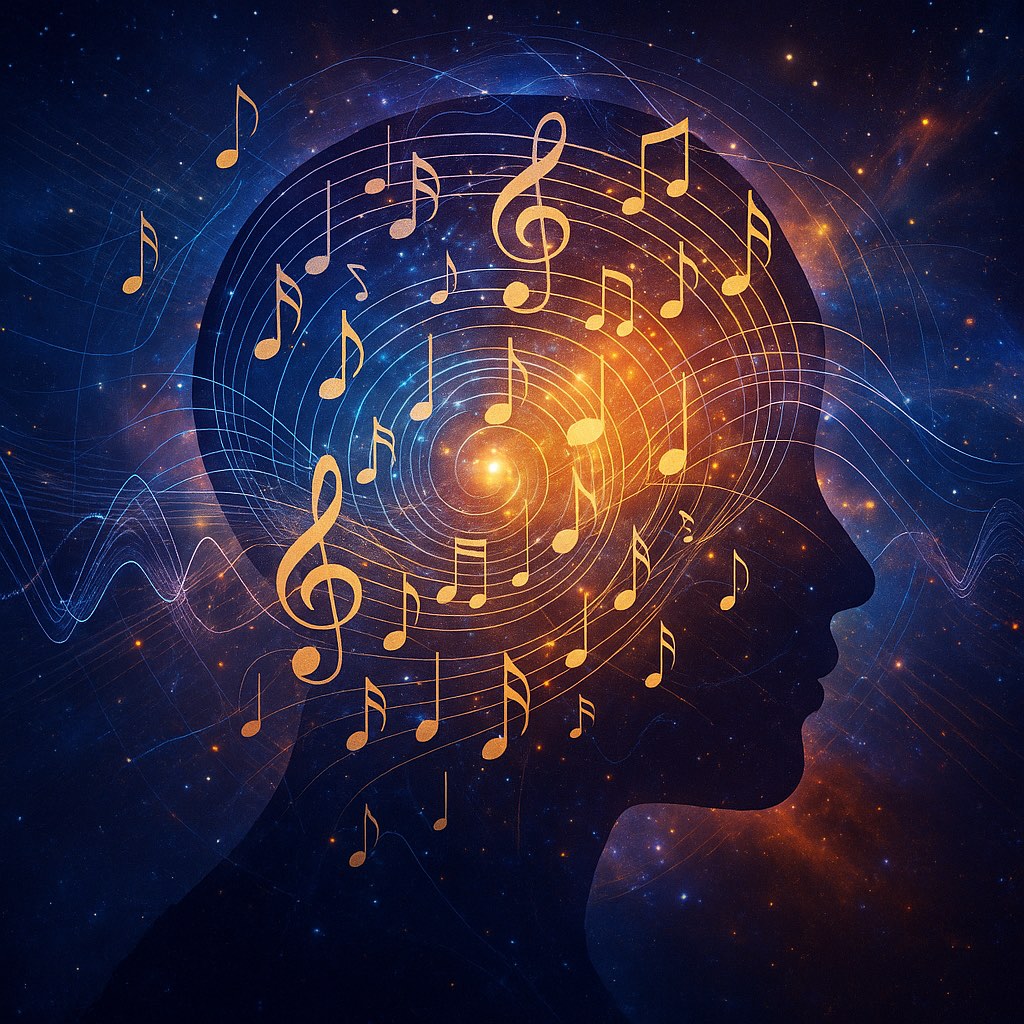Quantum Consciousness: The Symphony of Existence
featured image | by Pawel Czerwinski
This essay explores the possibility that consciousness is not merely a product of the brain, but a resonant phenomenon—an orchestration of wave patterns echoing across quantum fields, cultural traditions, and neural networks. Drawing from physics, music, and sacred practice, the piece invites readers to perceive mind and universe as intertwined in a grand symphony of coherence.
Introduction: The Universal Language of Waves
What if the mind is not simply a product of neural networks and synaptic exchanges, but a resonant pattern in a deeper, unmeasured field? This notion, as speculative as it may seem, beckons us to rethink consciousness not as mere computation, but as a vibrational phenomenon—an orchestra of waves harmonizing across quantum, biological, and cosmic scales.

Physicist Michio Kaku once described the universe as “a symphony of vibrating strings,” with the mind of God being “cosmic music resonating through 11-dimensional hyperspace.” I believe this poetic analogy is more than a metaphor. It reflects a potential reality: that everything from the dance of electrons to the oscillations of brainwaves is connected through the principles of wave theory. From this perspective, consciousness might not just emerge from brain matter but instead represent a coherent resonance within the quantum field—a quantum symphony woven into the very fabric of existence.
The Mathematics of Beauty: Waves Across Realms
Why does a major chord sound “right” across all cultures? Why do spirals, fractals, and golden ratios align with our sense of beauty? It’s not just coincidence—it’s math. The universal language of waves. Harmonic relationships, like the 2:1 ratio of an octave or the 3:2 of a perfect fifth, are not just musical constructs. They mirror the structural coherence found throughout nature and the cosmos.
Consider the moment when you hear a perfect harmony. What you are experiencing is the constructive interference of sound waves creating stable, reinforcing patterns. This same principle appears in quantum systems, where particles exist not as discrete objects but as probability waves, eternally oscillating in fields of potential. The mathematics that govern a beautiful sunset—the wavelengths of light interacting with atmospheric particles—share underlying principles with the resonant chambers of a violin and the synchronized firing of neurons during moments of insight.
From the spirals of nautilus shells to the frequency ratios in planetary orbits, the universe organizes itself with a musical logic. Herein lies the connection: if our brains process sound waves through mathematical resonance, could consciousness itself be a resonant phenomenon within quantum fields?
Quantum Fields and Consciousness
Quantum mechanics posits that particles are not solid objects but excitations in underlying fields, just like waves on the surface of a pond. These excitations—forming electrons, photons, quarks, etc.—are not isolated; they are entangled, dancing in harmony even across vast distances. If particles can maintain coherence across space, could consciousness be a field? Maybe a ripple in an ocean that has yet to be measured?
Grover’s algorithm in quantum computing offers an elegant metaphor. It finds solutions not by brute force but by amplifying correct answers through constructive interference while dampening incorrect ones through destructive interference. Similarly, perhaps thoughts are waves amplified and suppressed within the quantum mind. Our neurons, firing in synchronized oscillations, may not just transmit information but entangle with deeper layers of reality.
The double-slit experiment, where particles behave as waves until observed, hints at a profound connection between consciousness and quantum reality. The observer effect suggests that the act of physical perception itself influences the quantum state, collapsing probability waves into definite outcomes. What if consciousness is not merely observing this quantum dance but participating in it—a co-creator in the symphony of existence? All possible decisions existing in superposition until making one, collapses the wave function.
Neural Processing and Wave Mechanics: The Brain’s Symphony
 The human brain operates as a complex orchestra of electrical and chemical signals, producing rhythmic patterns as brainwaves. These oscillations, from delta to gamma frequencies, are not just byproducts of neural activity—they are integral to cognitive functions such as perception, attention, and consciousness.
The human brain operates as a complex orchestra of electrical and chemical signals, producing rhythmic patterns as brainwaves. These oscillations, from delta to gamma frequencies, are not just byproducts of neural activity—they are integral to cognitive functions such as perception, attention, and consciousness.
Recent studies suggest that brainwave patterns exhibit quantum-like properties. Some cognitive processes, like decision-making and memory, may be better explained by quantum probability models than classical ones. This relatively new field, known as quantum cognition, proposes that the probabilistic nature of quantum mechanics can account for the complexities and nuances of human thought.
Moreover, the phenomenon of neural synchrony—where disparate regions of the brain oscillate in unison—mirrors the concept of coherence in quantum systems. This type of coherence is essential for the integration of information across different neural networks, potentially highlighting the unified experience of consciousness. When we experience a unique qualia, a moment of clarity or profound insight, we might be witnessing a spontaneous coherence of neural oscillations: a harmonious alignment of brainwaves creating a unified field of awareness.
Cultural Resonance: Echoes of the Quantum Mind
Across every known human culture, music and rhythm have played a pivotal role, not merely as entertainment, but as tools for transformation. In sacred ceremonies, healing rituals, and ecstatic dances, sound has often been the bridge between the mundane and the transcendent. Consider the chant of a monk or the hypnotic beat of a drum—these are not random traditions but carefully honed sonic practices that reshape perception, inviting altered states of consciousness.
What’s astonishing is how this pattern repeats across the globe. People separated by oceans and centuries have discovered the same mathematical relationships in tone, rhythm, and harmony: a kind of geometry in motion. These musical structures aren’t just aesthetic; they resonate with the body, the breath, the brain.
Recent explorations into Neural Resonance Theory help shed light on this mystery. They suggest that rhythmic auditory patterns can entrain neural activity, coaxing brainwaves into synchrony with external stimuli. This phenomenon, called neural entrainment, can induce states of calm, focus, or even trance, pointing toward a deeply embedded relationship between the rhythms we hear and the rhythms within us.
One striking example is binaural beats, where two slightly different frequencies presented to each ear create the illusion of a third internal rhythm. This internal beat can, in turn, nudge the brain toward specific wave patterns associated with altered awareness. The same principle may apply across other modalities: visual flickers, coordinated movement, group chanting—each offering its own pathway to resonance and coherence.
Perhaps that’s why sacred spaces so often share certain features: symmetry, proportion, echo. From cathedrals to temples, these architectural forms may not just be symbolic—they may be functional, tuned in ways that shape the mental and emotional state of those who enter. These aren’t just buildings; they’re instruments.
Rosslyn Chapel and Cymatics
Seven miles south of Edinburgh is one of Scotland’s most magnificent and mysterious buildings. Rosslyn Chapel was built in the 15th century and its ornate stonework has been intriguing scholars ever since.
Cymatics is the visualization of sound and vibration in particulate matter and liquids, and is found in the art and designs of cultures from around the world and across the centuries and, most significantly, it is found in China, dating back through 5000 years of musical history. The early Chinese formulated their musical scales from the ‘observation of patterns in nature’, which led to the formulation of the first pentatonic and chromatic scales.
It is known that the co-designer of Rosslyn Chapels carvings, Sir Gilbert Haye, had traveled to far off Cathay, known today as Tibet, and he spent 14 years amassing great knowledge, knowledge that he returned with to Scotland, to embed in stone at Rosslyn Chapel.
The Harmonious Convergence of Science and Spirit
Quantum consciousness sits at the crossroads of science and mythos, where empirical evidence and experiential wisdom begin to speak the same language. By viewing consciousness as a resonant field, sensitive to both quantum fluctuations and cultural harmonics, we begin to outline a framework that honors both physics and feeling.
This isn’t merely philosophy. If resonance and coherence underpin awareness, then perhaps we can apply these principles more deliberately: in therapy, in education, in community design. From neurofeedback to meditative soundscapes, the future of well-being may depend on our ability to tune ourselves—to align body, mind, and environment like a well-calibrated instrument.

And there’s something even more provocative in this idea: that consciousness might extend beyond the skin. Just as entangled particles seem to defy distance, coherent minds may form subtle connections across space and time. What Carl Jung called the collective unconscious, and what many Indigenous philosophies have long described as the web of life, could, in fact, be real fields of meaning shaped by shared resonance.
To embrace the idea of a resonant universe is to see ourselves not as isolated minds but as active participants in a cosmic chorus. Each thought, each feeling, each gesture adds to the song. And perhaps what we call coherence—when things fall into place, when insight arrives, when we feel at home in the world—is not just an inner state, but a tuning with something larger: a fundamental alignment with the rhythm of reality itself.
References
Quantum-scale coherence in biology
- Long-lived quantum coherence can survive in living systems.
Engel et al., Nature 446 (2007) used two-dimensional electronic spectroscopy to reveal picosecond-scale electronic coherences in the FMO complex of green-sulphur bacteria, suggesting wavelike energy transfer in photosynthesis. This shows that “warm, wet and noisy” biochemistry does not automatically suppress quantum effects—supporting the plausibility of quantum processes in the brain. - Hypothetical nuclear-spin qubits in calcium-phosphate (Posner) molecules.
Fisher, PNAS (2025 pre-print) argues that entangled phosphate nuclear spins could retain coherence long enough to act as biological qutrits and influence neuronal signalling. This offers a concrete biochemical substrate that could mediate quantum information in neurons, dovetailing with Orch-OR-style arguments.
Quantum consciousness & Orch-OR
- Microtubules as sites of orchestrated objective reduction (Orch-OR).
Hameroff & Penrose, Physics of Life Reviews 11 (2014) present a comprehensive update of the Orch-OR hypothesis, addressing decoherence objections and incorporating new quantum-biology findings. This is the authoritative source for discussing quantum reduction in microtubules—along with its criticisms.
Quantum probability in cognition
- Human decisions sometimes follow quantum-probability (non-classical) patterns.
Wang et al., PNAS 111 (2014) show that context-order effects in survey questions are quantitatively predicted by quantum probability theory, outperforming classical Bayesian models—empirical backing for the “quantum cognition” section. - Overview of quantum modelling in psychology.
Busemeyer & Bruza, Current Directions in Psychological Science (2015) summarise evidence that quantum formalisms naturally capture the conjunction fallacy, order effects and other cognitive anomalies—providing a high-level review rather than a single experiment.
Neural resonance & rhythmic entrainment
- Brain oscillations entrain to rhythmic music at pulse and meter levels.
Large & Snyder, Music Perception 26 (2009) show with EEG/MEG that β/γ bursts in auditory-motor networks lock to musical beats, supporting Neural Resonance Theory. - Neural entrainment strength predicts the subjective “groove.”
Toiviainen et al., NeuroImage (2019) find that higher-frequency phase-locking correlates with the urge to move—bridging subjective cultural response with measurable neural resonance. - Binaural beats alter brain-wave spectra (systematic review).
García-Argibay et al., Psychological Research (2023) aggregate 22 EEG studies and show that low-frequency binaural beats reliably shift θ/α power, substantiating my binaural-beat example of auditory entrainment. - Recent EEG study linking binaural beats to anxiety reduction.
Shah et al., Frontiers in Human Neuroscience (2024) report that a 15-minute 6 Hz stimulus decreased self-reported anxiety and increased frontal-midline θ coherence, giving a fresh clinical angle for the applications section.







It’s becoming clear that with all the brain and consciousness theories out there, the proof will be in the pudding. By this I mean, can any particular theory be used to create a human adult level conscious machine. My bet is on the late Gerald Edelman’s Extended Theory of Neuronal Group Selection. The lead group in robotics based on this theory is the Neurorobotics Lab at UC at Irvine. Dr. Edelman distinguished between primary consciousness, which came first in evolution, and that humans share with other conscious animals, and higher order consciousness, which came to only humans with the acquisition of language. A machine with only primary consciousness will probably have to come first.
What I find special about the TNGS is the Darwin series of automata created at the Neurosciences Institute by Dr. Edelman and his colleagues in the 1990’s and 2000’s. These machines perform in the real world, not in a restricted simulated world, and display convincing physical behavior indicative of higher psychological functions necessary for consciousness, such as perceptual categorization, memory, and learning. They are based on realistic models of the parts of the biological brain that the theory claims subserve these functions. The extended TNGS allows for the emergence of consciousness based only on further evolutionary development of the brain areas responsible for these functions, in a parsimonious way. No other research I’ve encountered is anywhere near as convincing.
I post because on almost every video and article about the brain and consciousness that I encounter, the attitude seems to be that we still know next to nothing about how the brain and consciousness work; that there’s lots of data but no unifying theory. I believe the extended TNGS is that theory. My motivation is to keep that theory in front of the public. And obviously, I consider it the route to a truly conscious machine, primary and higher-order.
My advice to people who want to create a conscious machine is to seriously ground themselves in the extended TNGS and the Darwin automata first, and proceed from there, by applying to Jeff Krichmar’s lab at UC Irvine, possibly. Dr. Edelman’s roadmap to a conscious machine is at https://arxiv.org/abs/2105.10461, and here is a video of Jeff Krichmar talking about some of the Darwin automata, https://www.youtube.com/watch?v=J7Uh9phc1Ow
Thank you for sharing this resource, Grant!
The article beautifully aligns with QCCC’s view of consciousness as a quantum phenomenon, emphasizing resonance and cosmic unity. However, #QCCC dives deeper into empirical data and neural mechanisms, proposing a quantum syntax to solve the hard problem of #consciousness.
https://philarchive.org/rec/KHAQCC